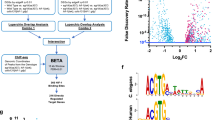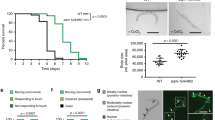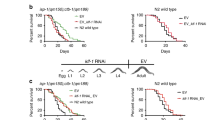Abstract
HIF-1-mediated adaptation to changes in oxygen availability is a critical aspect of healthy physiology. HIF is regulated by a conserved mechanism whereby EGLN/PHD family members hydroxylate HIF in an oxygen-dependent manner, targeting it for ubiquitination by Von-Hippel-Lindau (VHL) family members, leading to its proteasomal degradation. The activity of the only C. elegans PHD family member, EGL-9, is also regulated by a hydrogen sulfide sensing cysteine-synthetase-like protein, CYSL-1, which is, in turn, regulated by RHY-1/acyltransferase. Over the last decade, multiple seminal studies have established a role for the hypoxic response in regulating longevity, with mutations in vhl-1 substantially extending C. elegans lifespan through a HIF-1-dependent mechanism. However, studies on other components of the hypoxic signaling pathway that similarly stabilize HIF-1 have shown more mixed results, suggesting that mutations in egl-9 and rhy-1 frequently fail to extend lifespan. Here, we show that egl-9 and rhy-1 mutants suppress the long-lived phenotype of vhl-1 mutants. We also show that RNAi of rhy-1 extends lifespan of wild-type worms while decreasing lifespan of vhl-1 mutant worms. We further identify VHL-1-independent gene expression changes mediated by EGL-9 and RHY-1 and find that a subset of these genes contributes to longevity regulation. The resulting data suggest that changes in HIF-1 activity derived by interactions with EGL-9 likely contribute greatly to its role in regulation of longevity.





Similar content being viewed by others
References
Ackerman D, Gems D. Insulin/IGF-1 and hypoxia signaling act in concert to regulate iron homeostasis in Caenorhabditis elegans. PLoS Genet. 2012;8(3):e1002498.
Ahringer, J. (2006). Reverse genetics WormBook: The Online Review of C. elegans Biology [Internet]: WormBook.
Amrit FRG, Ratnappan R, Keith SA, Ghazi A. The C. elegans lifespan assay toolkit. Methods. 2014;68(3):465–75.
Angeles-Albores D, Robinson CP, Williams BA, Wold BJ, Sternberg PW. Reconstructing a metazoan genetic pathway with transcriptome-wide epistasis measurements. Proc Natl Acad Sci. 2018;115(13):E2930–9.
Ashok BS, Ajith TA, Sivanesan S. Hypoxia-inducible factors as neuroprotective agent in Alzheimer’s disease. Clin Exp Pharmacol Physiol. 2017;44(3):327–34.
Balamurugan K. HIF-1 at the crossroads of hypoxia, inflammation, and cancer. Int J Cancer. 2016;138(5):1058–66.
Bray NL, Pimentel H, Melsted P, Pachter L. Near-optimal probabilistic RNA-seq quantification. Nat Biotechnol. 2016;34(5):525–7.
Cockman ME, Masson N, Mole DR, Jaakkola P, Chang G-W, Clifford SC, et al. Hypoxia inducible factor-α binding and ubiquitylation by the von Hippel-Lindau tumor suppressor protein. J Biol Chem. 2000;275(33):25733–41.
Couillault C, Pujol N, Reboul J, Sabatier L, Guichou J-F, Kohara Y, et al. TLR-independent control of innate immunity in Caenorhabditis elegans by the TIR domain adaptor protein TIR-1, an ortholog of human SARM. Nat Immunol. 2004;5(5):488–94.
Darby C, Cosma CL, Thomas JH, Manoil C. Lethal paralysis of Caenorhabditis elegans by Pseudomonas aeruginosa. Proc Natl Acad Sci. 1999;96(26):15202–7.
Di Chen ELT, Kapahi P. HIF-1 modulates dietary restriction-mediated lifespan extension via IRE-1 in Caenorhabditis elegans. PLoS Genet. 2009;5(5):e1000486.
Epstein AC, Gleadle JM, McNeill LA, Hewitson KS, O'Rourke J, Mole DR, et al. C. elegans EGL-9 and mammalian homologs define a family of dioxygenases that regulate HIF by prolyl hydroxylation. Cell. 2001;107(1):43–54.
Franceschi C, Campisi J. Chronic inflammation (inflammaging) and its potential contribution to age-associated diseases. J Gerontol Series A. 2014;69(Suppl_1):S4–9.
Haase VH. Therapeutic targeting of the HIF oxygen-sensing pathway: lessons learned from clinical studies. Exp Cell Res. 2017;356(2):160–5.
Harris TW, Antoshechkin I, Bieri T, Blasiar D, Chan J, Chen WJ, et al. WormBase: a comprehensive resource for nematode research. Nucleic Acids Res. 2010;38(suppl_1):D463–7.
Horsman JW, Heinis FI, Miller DL. A novel mechanism to prevent H2S toxicity in Caenorhabditis elegans. Genetics. 2019;213(2):481–90.
Jiang H, Guo R, Powell-Coffman JA. The Caenorhabditis elegans hif-1 gene encodes a bHLH-PAS protein that is required for adaptation to hypoxia. Proc Natl Acad Sci. 2001;98(14):7916–21.
Leiser SF, Kaeberlein M. The hypoxia-inducible factor HIF-1 functions as both a positive and negative modulator of aging. Biol Chem. 2010;391(10):1131–7.
Leiser SF, Begun A, Kaeberlein M. HIF-1 modulates longevity and healthspan in a temperature-dependent manner. Aging Cell. 2011;10(2):318–26.
Leiser SF, Jafari G, Primitivo M, Sutphin GL, Dong J, Leonard A, et al. Age-associated vulval integrity is an important marker of nematode healthspan. Age. 2016;38(5–6):419–31.
Li X, Cui X-X, Chen Y-J, Wu T-T, Xu H, Yin H, et al. Therapeutic potential of a prolyl hydroxylase inhibitor FG-4592 for Parkinson’s diseases in vitro and in vivo: regulation of redox biology and mitochondrial function. Front Aging Neurosci. 2018;10:121.
Libert S, Chao Y, Chu X, Pletcher SD. Trade-offs between longevity and pathogen resistance in Drosophila melanogaster are mediated by NFκB signaling. Aging Cell. 2006;5(6):533–43.
Luhachack LG, Visvikis O, Wollenberg AC, Lacy-Hulbert A, Stuart LM, Irazoqui JE. EGL-9 controls C. elegans host defense specificity through prolyl hydroxylation-dependent and-independent HIF-1 pathways. PLoS Pathog. 2012;8(7).
Ma DK, Vozdek R, Bhatla N, Horvitz HR. CYSL-1 interacts with the O2-sensing hydroxylase EGL-9 to promote H2S-modulated hypoxia-induced behavioral plasticity in C. elegans. Neuron. 2012;73(5):925–40.
Marsh EK, van den Berg MC, May RC. A two-gene balance regulates Salmonella typhimurium tolerance in the nematode Caenorhabditis elegans. PLoS One. 2011;6(3):e16839.
Mehta R, Steinkraus KA, Sutphin GL, Ramos FJ, Shamieh LS, Huh A, et al. Proteasomal regulation of the hypoxic response modulates aging in C. elegans. Science. 2009;324(5931):1196–8.
Miller H, Fletcher M, Primitivo M, Leonard A, Sutphin GL, Rintala N, et al. Genetic interaction with temperature is an important determinant of nematode longevity. Aging Cell. 2017;16(6):1425–9.
Müller R-U, Fabretti F, Zank S, Burst V, Benzing T, Schermer B. The von Hippel Lindau tumor suppressor limits longevity. J Am Soc Nephrol. 2009;20(12):2513–7.
Murphy CT, McCarroll SA, Bargmann CI, Fraser A, Kamath RS, Ahringer J, et al. Genes that act downstream of DAF-16 to influence the lifespan of Caenorhabditis elegans. Nature. 2003;424(6946):277–83.
Nathoo AN, Moeller RA, Westlund BA, Hart AC. Identification of neuropeptide-like protein gene families in Caenorhabditis elegans and other species. Proc Natl Acad Sci. 2001;98(24):14000–5.
Park EC, Ghose P, Shao Z, Ye Q, Kang L, Xu XS, et al. Hypoxia regulates glutamate receptor trafficking through an HIF-independent mechanism. EMBO J. 2012;31(6):1379–93.
Pezzuto A, Carico E. Role of HIF-1 in cancer progression: novel insights. A review. Curr Mol Med. 2018;18(6):343–51.
Pimentel H, Bray NL, Puente S, Melsted P, Pachter L. Differential analysis of RNA-seq incorporating quantification uncertainty. Nat Methods. 2017;14(7):687–90.
Ramakrishnan SK, Shah YM. Role of intestinal HIF-2α in health and disease. Annu Rev Physiol. 2016;78:301–25.
Romero-Afrima L, Zelmanovich V, Abergel Z, Zuckerman B, Shaked M, Abergel R, et al. Ferritin is regulated by a neuro-intestinal axis in the nematode Caenorhabditis elegans. Redox Biol. 2020;28:101359.
Shao Z, Zhang Y, Powell-Coffman JA. Two distinct roles for EGL-9 in the regulation of HIF-1-mediated gene expression in Caenorhabditis elegans. Genetics. 2009;183(3):821–9.
Shao Z, Zhang Y, Ye Q, Saldanha JN, Powell-Coffman JA. C. elegans SWAN-1 binds to EGL-9 and regulates HIF-1-mediated resistance to the bacterial pathogen Pseudomonas aeruginosa PAO1. PLoS Pathog. 2010;6(8).
Shen C, Nettleton D, Jiang M, Kim SK, Powell-Coffman JA. Roles of the HIF-1 hypoxia-inducible factor during hypoxia response in Caenorhabditis elegans. J Biol Chem. 2005;280(21):20580–8.
Shen C, Shao Z, Powell-Coffman JA. The Caenorhabditis elegans rhy-1 gene inhibits HIF-1 hypoxia-inducible factor activity in a negative feedback loop that does not include vhl-1. Genetics. 2006;174(3):1205–14.
Stiernagle T. Maintenance of Caenorhabditis elegans. African Scientist. 2019;16(2):55–68.
Treinin M, Shliar J, Jiang H, Powell-Coffman JA, Bromberg Z, Horowitz M. HIF-1 is required for heat acclimation in the nematode Caenorhabditis elegans. Physiol Genomics. 2003;14(1):17–24.
Trent C, Tsung N, Horvitz HR. Egg-laying defective mutants of the nematode Caenorhabditis elegans. Genetics. 1983;104(4):619–47.
Zhang Y, Shao Z, Zhai Z, Shen C, Powell-Coffman JA. The HIF-1 hypoxia-inducible factor modulates lifespan in C. elegans. PLoS One. 2009;4(7).
Acknowledgments
We thank David Angeles and the Sternberg lab for sharing their Kallisto analyses and expertise.
Funding
This work was supported by NIH R01AG058717 and the Glenn Foundation for Medical Research. HAM was supported by NIH F31AG060663. Additionally, the University of Washington Nathan Shock Center provided support of gene expression analysis (NIH P30AG013280). Strains were provided by the Caenorhabditis Genetics Center that is funded by the NIH ORIP (P40OD010440).
Author information
Authors and Affiliations
Corresponding author
Additional information
Publisher’s note
Springer Nature remains neutral with regard to jurisdictional claims in published maps and institutional affiliations.
Electronic supplementary material
Supplementary Figure 1.
rhy-1-mediated effects of lifespan. A-C) Individual lifespan experiments with N2 and rhy-1(ok1402) animals treated with empty vector or vhl-1(RNAi). D). Additional lifespan trial comparing N2 and rhy-1(ok1402) lifespans on empty vector RNAi. E. Aggregated data from A-C. (PNG 262 kb)
Supplementary Figure 2.
Effects of additional VHL-1/EGL-9 antagonistic HIF-1 targets on lifespan. A, C) expression levels of selected transcripts from RNA-seq analyses. B-D) Treatment with ftn-1(RNAi), and ftn-2(RNAi) increases lifespan of egl-9(sa307);vhl-1(ok161) mutants (p < 0.05 by log-rank). Lifespan data are aggregated from at least three experiments, and are significant (p < 0.05 by log-rank with Bonferroni correction) in 2 out of 4 individual trials (Supplementary Table 2). (PNG 153 kb)
Supplementary Table 1
(XLSX 15 kb)
Supplementary Table 2
(XLSX 18 kb)
Supplementary Table 3
(XLSX 11 kb)
Supplementary Table 4
(XLSX 39 kb)
Supplementary Table 5
(XLSX 18 kb)
Supplementary Table 6
(XLSX 19 kb)
About this article
Cite this article
Kruempel, J., Miller, H.A., Schaller, M.L. et al. Hypoxic response regulators RHY-1 and EGL-9/PHD promote longevity through a VHL-1-independent transcriptional response. GeroScience 42, 1621–1633 (2020). https://doi.org/10.1007/s11357-020-00194-0
Received:
Accepted:
Published:
Issue Date:
DOI: https://doi.org/10.1007/s11357-020-00194-0




